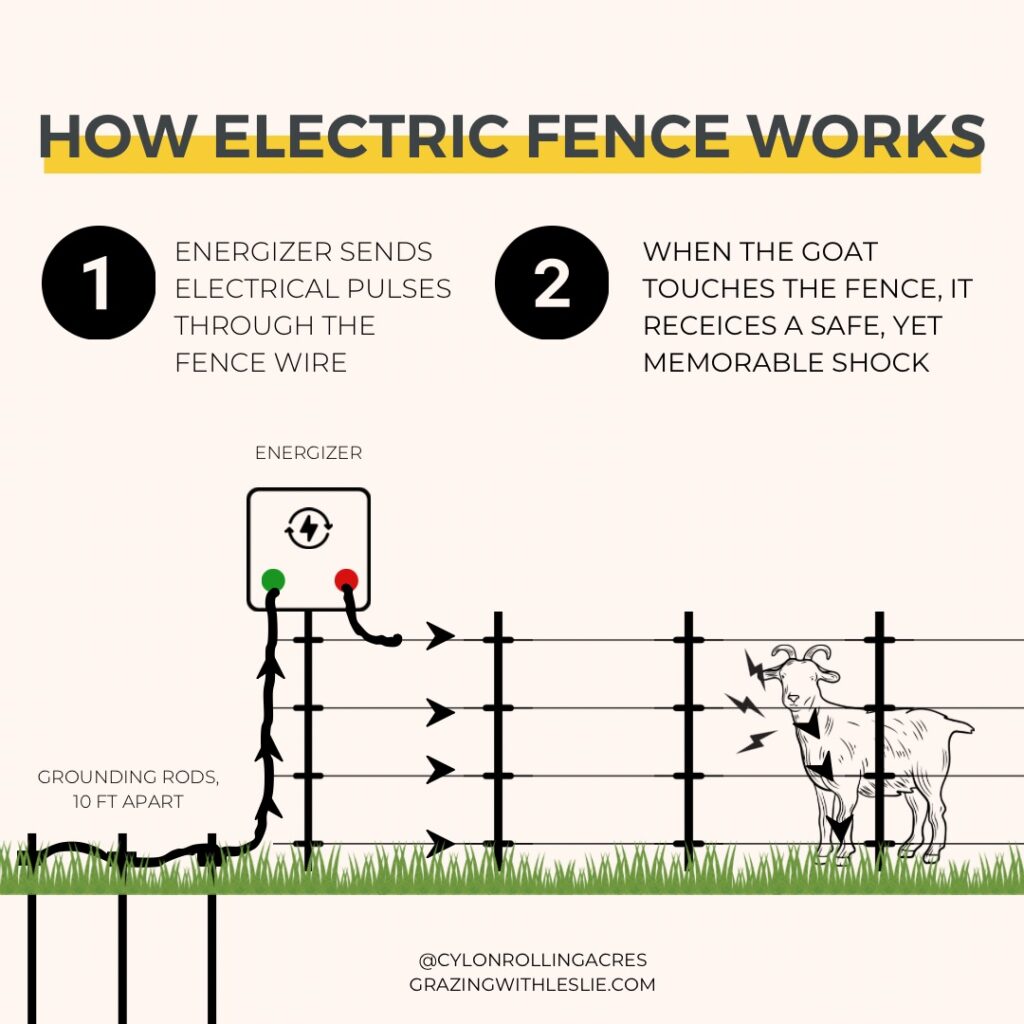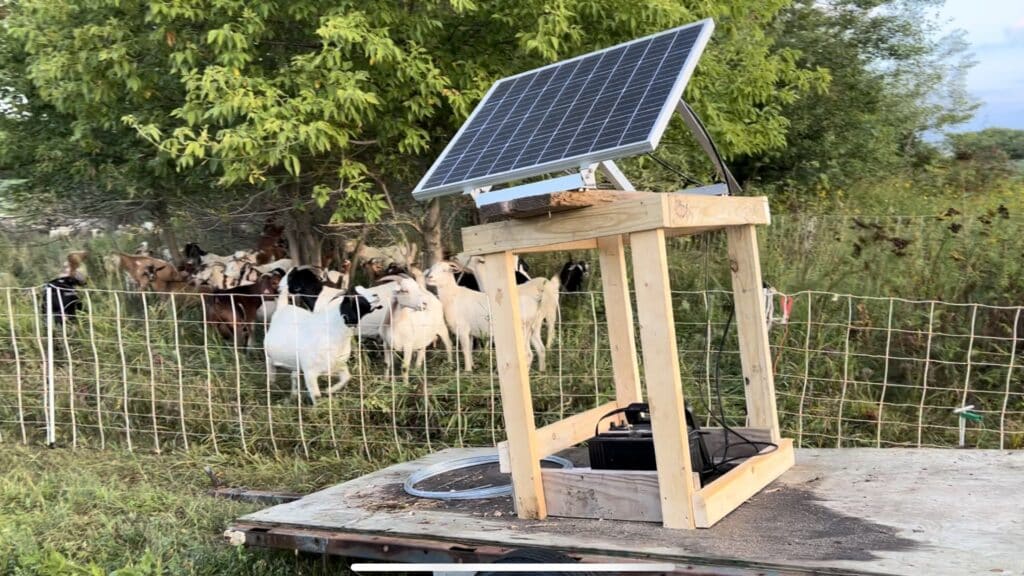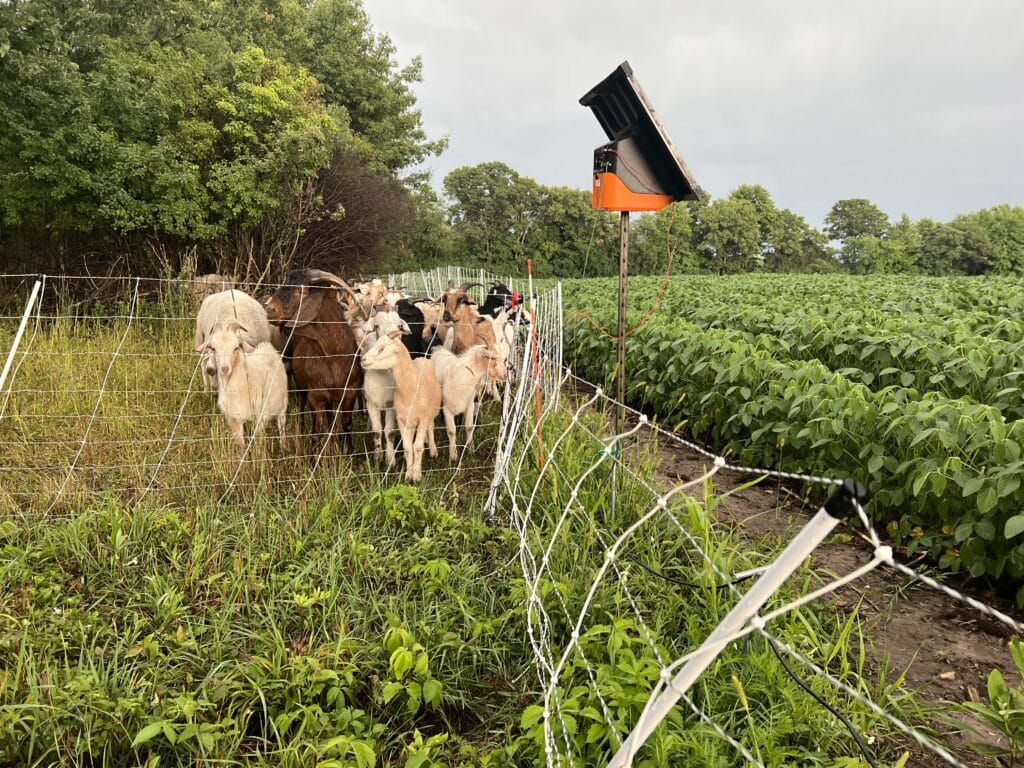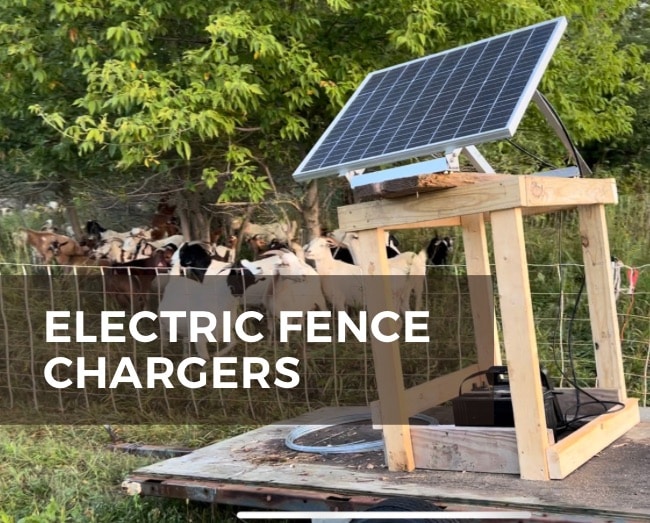I may earn affiliate income from links in the blog post. I only promote products I actually use in my farm and business.
Electric fence chargers are what makes your fence, literally a powerful tool, in keeping your livestock in your pasture and predators out. Choosing the right fence charger, sized for your fencing situation is important in making it truly effective.
Fences not only keep your livestock, such as goats and sheep like I raise, safe from predators, but they also help keep them safe from other situations as well, such as getting into a neighbor’s soybean field or flower garden, or even venturing into a nearby road and causing accidents.
If your livestock are properly trained to fences powered with a fence charger it can make your life a lot easier in using this tool to manage your farm or ranch.
Electric fence chargers, sometimes also called an electric fence energizer, can be used with permanent pasture fences where they are installed for making the fence hot. Or, fence chargers can be used with portable fencing situations with poly wire or electronet where there’s not a traditional power source. Often these fence run off solar fence chargers.
This blog post will cover what you need to know about electric fence chargers, including how they work, information on joules and volts, choosing a fence charger, solar fence chargers, set up, and grounding.
How does electric fence work?
Electric fence works by producing a pulsed electric current along the “hot” wire from the fence charger which is grounded. It produces a short, safe shock when an animal touches the fence since it completes the circuit between the fence and the ground.
The safe shock is typically memorable enough to keep livestock inside the fence, creating both a psychological and physical barrier.
However, it’s important that the fence charger is powerful enough to work, which will be covered below. Additionally, your livestock should be trained to the electric fence so they learn to respect it right away, instead of “learning” on out on the pasture and potentially running through the fence instead of staying in. This is especially important with goats and sheep. You can learn more about how to fence train in this free guide.
Components to make this set up work include:
- Fence charger
- Grounding rods
- Fence
- Power source: 110v plug in, 12-volt battery or solar

Fence chargers: Joules and volts
Joules stored and output
Electric fence chargers are are rated on stored joules, which is how much energy stored in the charger for each pulse. Output joules is the energy that can be provided or put out in each pulse.
Think of stored joules as your energizer’s “potential.” The higher the joules, the greater the ability the charger can still deliver and a strong enough electrical pulse with shorts or faults from grass or weeds, as well as larger paddocks.
How many joules for goats?
You’ll first need to take a look at how many feet or miles of fencing you’ll be energizing with your charger. This will indicate the size electric fence charger you need, based on ratings of distance. However, from there it’s recommended to size up a charger or more to make sure you have enough joules to produce the voltage needed for goats.
Voltage output
Voltage is a measure of the electrical current moving through the fence from the charger.
The recommended voltage for sheep and goats is 5,000 to 7,000 kw, but ideally it should be about 7,000 kw. Possibly, lower voltage could work if livestock are properly trained to respect the fence and they have enough to eat in the paddock where they are enclosed.
Choosing an electric fence charger
Choosing the right electric fence charger isn’t a straightforward decision. It includes a number of different factors including:
- Distance of fencing used (double this if you’re using two wires, triple with three strands, etc.)
- Number of wires or type of fencing used
- Type of livestock being used with the fence
- Expected weed pressure
Typical miles ratings from energizer manufactures are based on a single strand of wire with no weed interference. In many cases with goats and sheep you’ll be using multi wires, strands of poly wire or a net fence, which uses more “miles” than a single wire. Additionally, it’s likely there will be more weed pressure on goat and sheep fence due to the smaller stature of small ruminants and their young stock.
Goats and sheep also have smaller hooves so it takes more for them to ground the electric pulse of the fence, therefore requiring a greater level of voltage output compared to other livestock (7k kw).
As a result, it’s best to use the miles rating as a starting point for selecting an electric fence charger. Then, size up energizer sizes 2-3x based on joules as much as you can afford to allow for more strength.
Choose your power source
You’ll also need to choose your power source for your fence charger, which there are three common options:
- 110 v plug in
- 12 volt battery
- Solar panel with battery
While some fence chargers are only 110v plug in, many can be adapted to be used with a battery, which can be switched out as needed, or a battery with a solar charger.
Depending on how you’ll use your fence energizer will likely dictate the type of power source. If you’re using movable fence, such as poly wire or electric net fencing, you’ll likely need a portable fence charger with a battery or solar set up.
Additionally, you’ll need to make sure your energizer is set up with grounding rods for proper grounding. More information is available later in this article.
Solar electric fence charger
Solar electric fence chargers are a great option for grazing livestock off grid or in places where portable fencing is required and there’s no access to electricity.
There are several types of solar fence chargers available:
- All-in-one options – where the charger, solar panel and battery are packaged together in one unit. These can be especially handy for portable grazing systems since they can be easily set up and moved. However, they often have limits to how much power they can produce, which may not work as well for larger runs of electric fencing, netting and/or livestock species such as goats and sheep.
- A-la-cart option – This is where you can pair your choice of fence charger with the right size solar panel, along with a 12 volt battery to create your own DIY solar electric fence charger set up. This is a great option if you’re wanting to cover larger areas with portable fencing, working with more weed interference, and grazing with small ruminants, such as goats and sheep.
In each option, you’ll also need to include the right amount of grounding to go along with your chosen fence charger. See the respective section on grounding for more information.
On our farm we’ve been using a DIY solar power electric fence kit as we’ve been grazing our goats and sheep on our hayfields and in our woods where we don’t have access to electricity. We’re using the MBS 800 multi power fence charger from Gallagher paired with an 80 watt solar panel, which recharges a 12 volt deep cycle battery. We have this setup mounted to a trailer so it is easier to move with our quick paddock rotations of 1-3 days.
How to ground an electric fence
Grounding an electric fence is extremely important. In fact, where there are issues of electric fences not working, usually it is because of grounding issues or not enough grounding rods.
How many grounding rods for electric fence?
A rule of thumb is at least three feet of grounding rod per joule of output with the fence charger. At least three grounding rods should be used for a fence charger.
More grounding rods may be needed for conditions such as dry, rocky, sandy or even frozen soil.
Depth of grounding rods
Grounding rods should be at least six feet in length.
Connecting grounding rods
Grounding rods should be installed at least 10 feet apart, using one line of galvanized wire, connecting all rods used. Copper wire is not recommended for use with grounding rods with electric fence.
Portable grounding rods
With a portable fencing system you’ll want to use grounding rods that are easier to put in and take out. We like to use grounding rods with a “T” top so we can pound them in with a mallet and use a t-post puller with a chain to pull them out as the fence charger is moved.
How to hook up an electric fence charger
To hook up an electric fence charger first you’ll need to determine where you will put it.
- The energizer will need to be mounted to a wall, fence post or even a trailer, depending on where it will be used. It shouldn’t sit directly on the ground, especially if it has a battery since that will drain the battery faster.
- Install at least three grounding rods, 10 feet apart, connected with galvanized wire. On the energizer’s green/earth terminal, connect a lead line to the grounding rod.
- With the power turned off on the fence charger, connect the battery, with the red lead to the + positive terminal and black lead to the – negative terminal on the battery.
- Then connect the charger red terminal with lead line to the fence wire.
- To power on the fence, turn on the fence charger.
Be sure to check the voltage output of your fence to make sure the fence charger is properly working. To do so, use a fence checker or fault finder to check the kw output of the energizer.
If the charger it’s not showing at least 3,000 kv of energy, you’ll want to start troubleshooting the connection and where there might be grounding problems.
Remember your fence and it’s charger is only as good as the training of your training of your goats and sheep with learning to respect the electric fence.
Electric fence chargers we’re using on our goat and sheep farm
On our goat and sheep farm Cylon Rolling Acres, we’re using several different fence energizers, all from Gallagher Animal Management. With all of our fences, we’re testing and checking the fence charger power with either a fence voltage indicator or fault finder.
Here’s what we’re using and the context of our set up:
Permanent pasture fence charger
We have three permanent pastures, fenced with woven wire and one strand of hot, electrified wire at the top. We’re using roughly (xx miles of energized fence). Additionally, we are using Gallagher’s Smart Fence, a portable-all-in-one poly wire fence, for creating paddocks of about 1 acre in size.
In this set up, we’re using a 110v, plug in powered energizer, the M1500 from Gallagher with three grounding rods to power our permanent pasture grazing system.
Portable, off grid grazing setup 1 – solar fence charger
We graze our goats and sheep in our hayfields and woods. We have two set up options for this grazing system.
We’re using a Gallagher MBS 800 with a 80 watt solar panel with three grounding rods to create a custom solar fence charger to use with 6-7 electrified net fences (164 feet) at time. This 8 joule energizer, easily powers this setup putting out 7,000 kw of power. It can likely handle more fences if needed.
Even though this particular Gallagher solar fence charger set up includes multiple parts (vs. an all-in-one) it was very easy to set up with lead lines connecting the solar panel to the battery and the energizer. We have it set up on a trailer so its easier to move no matter where we are at.

Portable, off grid grazing set up 2 – solar fence charger
Our second portable grazing system with portable fences and energizer is used in the same conditions, grazing off grid, outside of our permanent pastures in our woods and hayfields.
This system uses Gallagher’s all-in-one solar fence charger, the S400. Since this is a smaller charger than our other grazing system, it can handle about 4 electric net fences at a time, so we use it to graze with our market goats and lambs and breeding bucks and rams, since this is a smaller group in the summer. This particular Gallagher solar fence charger is very easy to use since it’s all enclosed in one piece of equipment — the solar panel is a part of the actual energizer and has two batteries enclosed inside the unit. It mounts on a t-post and uses three grounding rods.

Video overview
References:
- Conversation with Ray Williams, Director of Technical Operations, Gallagher
- Electric Fencing 101, Gallagher.
- Electric fencing for serious grazers, NRCS

LEAVE A COMMENT
Comments